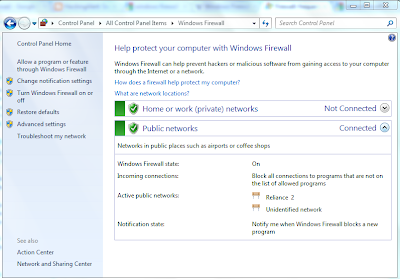Hello Friends. Recently one of my college friend asked me about Windows firewall.
The problem he asked quiet common among various network enthusiasts
and professionals. Understanding windows Firewall is as important as understanding
the function of Recycle Bin(hope you all are aware of Recycle bin).
So I thought to start a small series on windows firewall. I will deal with windows 7
and 8 firewall settings and focus mainly on its configuration and handling. This post
will be handy for Network administrators as well.
Let us start with some basics.
Firewall is a hardware or software that monitors data traffic of a network or a single
machine and prevents it from unauthorized access. There are several types of firewalls based on their working.
Types of Firewall
Network-Level Firewalls
Firewall come into being in 1988 effort at the network level. The objective of firewall is to examine sachet headers and clean traffic based on the IP address of the starting place and the target. Some of these primitive safety applications could also sort out packets based on protocols. Network-Level Firewalls are very fast and upcoming technologies you will find them built in network appliances specially routers. Firewall has no aware of any language such as HTML, XML therefore Firewall capable of decoding SSL encrypted packets to inspect their data or text.
Circuit-Level Firewalls
Circuit-Level Firewalls applications represent the technology of next to first generation .Firewall technology supervise TCP handshaking among packets to confirm a session is genuine. Firewall traffic is clean based on particular session rules and may be controlled to acknowledged computers only. Circuit-level firewalls conceal the network itself from the external, which is helpful for contradicting access to impostors. But Circuit-Level Firewalls don't clean entity packets
Application-Level Firewalls
Application-Level Firewalls which is also called proxies have been appearing more intensely into the application data going away their filters. By considering the perspective of user requirements and appliance responses, Application-Level Firewalls Attempt to implement exact application conduct, block malevolent action and help business companies make sure the security of responsive information and systems. Application-level filtering also used to protect your system against spam and viruses. It is also capable to block may include protection against spam and viruses as well, and be able to block unwanted Web sites.
Let us quickly move to windows firewall. Windows has been working really hard on its firewall settings since it failed to deliver a stable firewall for XP. The current version is in windows 7 is safe but it is buggy as well( explained later).
Windows Firewall is on by default in this version of Windows. To make sure it hasn't been turned off, follow these steps:
Open Windows Firewall by clicking the Start button , and then clicking Control Panel. In the search box, type firewall, and then click Windows Firewall.
In the left pane, click Turn Windows Firewall on or off. If you're prompted for an administrator password or confirmation, type the password or provide confirmation
Below each network location type, click Turn on Windows Firewall, and then click OK. We recommend that you turn on the firewall for all network location types.
Time to start playing. Go to control panel and open firewall. You will see a beautiful interface similar to the one shown in figure.
So now there are two big questions (in my mind) that needs to be addressed. Let us start with the first one.
How can I manage my firewall connections?
Simple. Click on "allow program or feature through Firewall". YOu will be presented with a list of programs that can communicate through the firewall. Well the next question comes in now.
What does "allowing a program to communicate through the firewall" mean?
Allowing a program to communicate through the firewall, sometimes called unblocking, is when you allow a particular program to send information through the firewall. You can also allow a program to communicate through the firewall by opening one or more ports.
So now you have a basic understanding of what communicating through firewall means. Now to change the communication settings go to Allow program or feature through Firewall > Change Settings
Now here you can see which softwares are stabbing your back by making unknown connections. You can control your traffic as well as privacy through this setting. You never know when you can find a suspicious software is fooling the Giant Microsoft and running unblocked. I found one on my system. Check out the image.
This is a small introductory post. Since I have never written about firewalls so I went deeper into basics. In the next post we will move a step ahead and learn how to view log files and analyse the traffic. Further we will learn how to open/close ports on windows firewall. We will also learn how to allow programs to communicate across firewall. You can post your feedback and comments here. DO tell what else you want to read about.
Read the next post to this sequence here - How to close/open ports in Windows Firewall.



You will be presented with a list of programs that can communicate through the firewall. Well the next question comes in now.Firewall is a hardware or
RépondreSupprimersoftware that monitors data traffic of a network or a single machine and prevents it from unauthorized access. malwarebytes-anti-malware-key